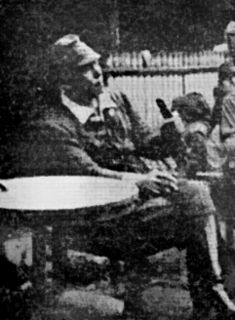
Takurō Matsui (松井 太久郎; Fukuoka Prefecture, 3 December 1887 – 10 June 1969) was a Lieutenant General in the Imperial Japanese Army in World War II.

Fukuoka Prefecture is a prefecture of Japan on Kyūshū Island. The capital is the city of Fukuoka. As of 2018, it is the ninth most populated prefecture in Japan.

The Imperial Japanese Army was the official ground-based armed force of the Empire of Japan from 1868 to 1945. It was controlled by the Imperial Japanese Army General Staff Office and the Ministry of the Army, both of which were nominally subordinate to the Emperor of Japan as supreme commander of the army and the navy. Later an Inspectorate General of Aviation became the third agency with oversight of the army. During wartime or national emergencies, the nominal command functions of the emperor would be centralized in an Imperial General Headquarters (IGHQ), an ad-hoc body consisting of the chief and vice chief of the Army General Staff, the Minister of the Army, the chief and vice chief of the Naval General Staff, the Inspector General of Aviation, and the Inspector General of Military Training.

World War II, also known as the Second World War, was a global war that lasted from 1939 to 1945. The vast majority of the world's countries—including all the great powers—eventually formed two opposing military alliances: the Allies and the Axis. A state of total war emerged, directly involving more than 100 million people from over 30 countries. The major participants threw their entire economic, industrial, and scientific capabilities behind the war effort, blurring the distinction between civilian and military resources. World War II was the deadliest conflict in human history, marked by 50 to 85 million fatalities, most of whom were civilians in the Soviet Union and China. It included massacres, the genocide of the Holocaust, strategic bombing, premeditated death from starvation and disease, and the only use of nuclear weapons in war.
Matsui commanded the Western District Army between 15 July 1938 and 9 March 1940.
The Western District Army was a regional command of the Imperial Japanese Army responsible for the defense of the Kantō region and western Honshū, Shikoku and Kyūshū during the Pacific War. It was one of the regional commands in the Japanese home islands reporting to the General Defense Command.
He received command of the 5th Japanese Division on 15 October 1940, which fought at that time in China in the Second Sino-Japanese War. [1] On 8 December 1941, his division landed on the beaches of Southern Thailand and fought with success in the Malayan Campaign and the following Battle of Singapore. [2]

The 5th Division was an infantry division of the Imperial Japanese Army. Its call-sign was the Carp Division. The 5th Division was formed in Hiroshima in January 1871 as the Hiroshima Garrison, one of six regional commands created in the fledgling Imperial Japanese Army, and was destroyed in the battle of Okinawa in June 1945. Its personnel were drafted from Hiroshima, Yamaguchi and Shimane.

The Second Sino-Japanese War was a military conflict fought primarily between the Republic of China and the Empire of Japan from July 7, 1937, to September 2, 1945. It began with the Marco Polo Bridge Incident in 1937 in which a dispute between Japanese and Chinese troops escalated into a battle.

The Malayan Campaign was a military campaign fought by Allied and Axis forces in Malaya, from 8 December 1941 – 31 January 1942 during the Second World War. It was dominated by land battles between British Commonwealth army units, and the Imperial Japanese Army with minor skirmishes at the beginning of the campaign between British Commonwealth and Royal Thai Armed Forces. The Japanese had air and naval supremacy from the opening days of the campaign. For the British, Indian, Australian and Malayan forces defending the colony, the campaign was a total disaster.
On 11 May 1942, he was replaced at the head of the division by Lieutenant General Yamamoto Tsutomi.
On 18 March 1943 he became Chief of Staff of the China Expeditionary Army, a post he would hold until 1 February 1945, when he became commander until the end of the War of the Thirteenth Army, posted in the lower Yangtze River area of east central China.
The China Expeditionary Army was an army group of the Imperial Japanese Army during the Second Sino-Japanese War and World War II. It was responsible for all military operations in China, and at its peak had over 1 million soldiers under its command. In military literature, it is often referred to by the initials CEA.
The Japanese 13th Army was an army of the Imperial Japanese Army during the Second Sino-Japanese War and World War II.














